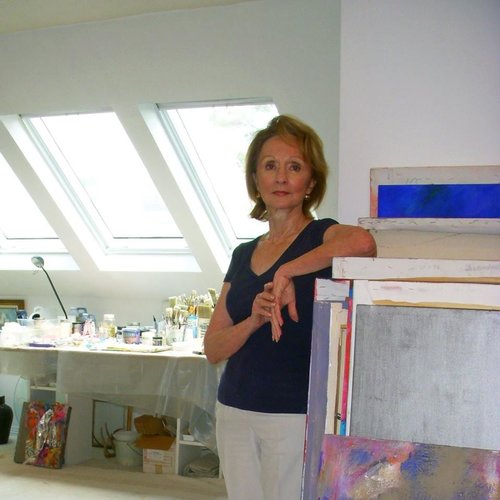Fine artists can take advantage of opportunities to wholesale their work. Here’s how.
.

Artist Marilyn Biles is a wholesale exhibitor at the American Made Show in Dallas this summer.
The traditional way fine art is sold is on a consignment basis, through brick and mortar galleries. A 50/50 split or other similar arrangement is made. Payment to the artist is made when the work is sold, and the gallery keeps the commission they have earned. This model isn’t going away. But, artists have other options as well.
Besides consignment, fine artists can retail their work in person, sell it directly on line, take commissions, etc. But – they may have a place at the table for wholesaling, too. This is a different business model entirely that drives consistent income.
Wholesaling is selling outright to a retailer at approximately the same price as the artist half of a consignment sale. The retailer marks up the work and sells to the public. They own the goods they have purchased, which naturally means they have a great incentive to sell it. The wholesale customer reorders from the artist when inventory needs replenishing. When they are successful with sales, it means that the artist can build a strong ongoing relationship with the retailer. This provides the artist consistent income from sales, and they are paid upfront (or on a Net 30 basis) for their work.
Typical exhibitors in wholesale trade shows are designers and makers in all mediums. They create work in a production studio setting to sell to wholesale buyers. They may be potters, fiber artists, jewelry designers, etc.
Can fine artists get a piece of this market, too?
Yes. Wendy Rosen, founder of the American Made Show which partners with the Dallas Market Center to present handmade work and art to wholesale buyers from around the country, explains how a fine artist can become involved.
.

Dallas Market Center offers 14 stories of permanent showrooms and temporary spaces.
.
“There was a time when consignment was the only way to sell to galleries and shops,” she says. “That was certainly true when artists made their living from only originals at high price points. Today few artists rely on just one income stream, and one price point. Success depends on leveraging your property (every design or painting) beyond the sale of the original. Today with Epson and Canon printers and other technology, you can reproduce your images on products made of canvas, paper, fabric, plastic, silk scarves, wood and even ceramic tiles.”
“This provides your galleries and shops with a way to sell your work to customers who just can’t afford an original,” she explains. “It makes your work a ‘gift’ rather than an investment. And it promotes your work beyond your limited local audience. Lower-priced prints and reproductions on products are perfect items to be purchased outright by galleries and shops, rather than consigned.”
What type of buyers attend a trade show who might be a good prospect to purchase fine art?
Rosen replies, “Affordable reproductions will sell ‘wholesale’ to interior designers, lighting stores, specifiers and architects who have storefronts and/or need eight copies for hotel rooms. In the last five years I’ve watched as more and more fine artists tested and succeeded in selling wholesale at the Dallas Market Center. The market for ‘good art’ originals is growing and every casino, hotel or model home is upgrading their decor to draw a more affluent customer. That includes better art.”
There is a transition going on in brick and mortars searching for additional market share of their own. “Most retail stores are joining the trend of becoming multi-category or ‘blended’ stores with crossovers happening between gift and art, home and art, lighting and art. Even jewelry stores are carrying art,” says Rosen.
She adds, “Dallas is somewhat unique because the gift show is held in conjunction with the Home Furnishings and the National Lighting show. Unlike many other markets, everything is under one roof, in 14 stories of showrooms and temporary spaces. There are six floors of home decor, three floors of gift, two floors of apparel, and one floor of just holiday display. The strict organization makes Dallas a most convenient buying experience. You can see more with fewer steps.”
The market weeks in January and June draw as many as 25,000 top buyers from business sectors that include casinos, five star hotels, cruise ships, tourist attractions, museums, and building developers. If this type of buyer is a fit for your work, you may consider this opportunity.

You can try using line sheets to sell your products. Having a line sheet/catalog of your products makes selling products easier. All pricing & important product information should be on a line sheet. Great article!!
I have been selling my art for 15 years. Its been a successful, especially at the “wholesale prices”. You sell to the retailer and you get your in the bank ASAP. I sell originals of any type of genre, media or sizes. Always, according to the customers specifications and representations. It is a slow process to get there, but once you do, the profit margin is there. Thank you.
Hi Andre,
Do you have advice on where to start in this space?
I am at scratch. Thank you